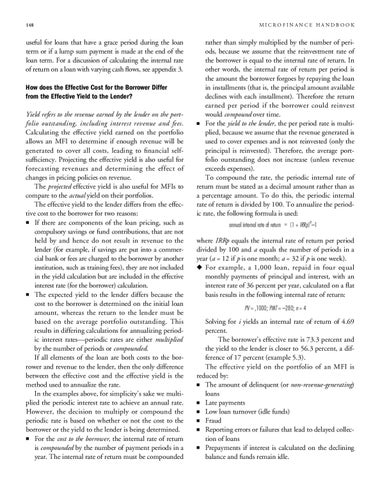148
useful for loans that have a grace period during the loan term or if a lump sum payment is made at the end of the loan term. For a discussion of calculating the internal rate of return on a loan with varying cash flows, see appendix 3. How does the Effective Cost for the Borrower Differ from the Effective Yield to the Lender? Yield refers to the revenue earned by the lender on the portfolio outstanding, including interest revenue and fees. Calculating the effective yield earned on the portfolio allows an MFI to determine if enough revenue will be generated to cover all costs, leading to financial selfsufficiency. Projecting the effective yield is also useful for forecasting revenues and determining the effect of changes in pricing policies on revenue. The projected effective yield is also useful for MFIs to compare to the actual yield on their portfolios. The effective yield to the lender differs from the effective cost to the borrower for two reasons: ■ If there are components of the loan pricing, such as compulsory savings or fund contributions, that are not held by and hence do not result in revenue to the lender (for example, if savings are put into a commercial bank or fees are charged to the borrower by another institution, such as training fees), they are not included in the yield calculation but are included in the effective interest rate (for the borrower) calculation. ■ The expected yield to the lender differs because the cost to the borrower is determined on the initial loan amount, whereas the return to the lender must be based on the average portfolio outstanding. This results in differing calculations for annualizing periodic interest rates—periodic rates are either multiplied by the number of periods or compounded. If all elements of the loan are both costs to the borrower and revenue to the lender, then the only difference between the effective cost and the effective yield is the method used to annualize the rate. In the examples above, for simplicity’s sake we multiplied the periodic interest rate to achieve an annual rate. However, the decision to multiply or compound the periodic rate is based on whether or not the cost to the borrower or the yield to the lender is being determined. ■ For the cost to the borrower, the internal rate of return is compounded by the number of payment periods in a year. The internal rate of return must be compounded
MICROFINANCE HANDBOOK
rather than simply multiplied by the number of periods, because we assume that the reinvestment rate of the borrower is equal to the internal rate of return. In other words, the internal rate of return per period is the amount the borrower forgoes by repaying the loan in installments (that is, the principal amount available declines with each installment). Therefore the return earned per period if the borrower could reinvest would compound over time. ■ For the yield to the lender, the per period rate is multiplied, because we assume that the revenue generated is used to cover expenses and is not reinvested (only the principal is reinvested). Therefore, the average portfolio outstanding does not increase (unless revenue exceeds expenses). To compound the rate, the periodic internal rate of return must be stated as a decimal amount rather than as a percentage amount. To do this, the periodic internal rate of return is divided by 100. To annualize the periodic rate, the following formula is used: a annual internal rate of return = (1 + IRRp) –1
where IRRp equals the internal rate of return per period divided by 100 and a equals the number of periods in a year (a = 12 if p is one month; a = 32 if p is one week). ◆ For example, a 1,000 loan, repaid in four equal monthly payments of principal and interest, with an interest rate of 36 percent per year, calculated on a flat basis results in the following internal rate of return: PV = ,1000; PMT = –280; n = 4
Solving for i yields an internal rate of return of 4.69 percent. The borrower’s effective rate is 73.3 percent and the yield to the lender is closer to 56.3 percent, a difference of 17 percent (example 5.3). The effective yield on the portfolio of an MFI is reduced by: ■ The amount of delinquent (or non-revenue-generating) loans ■ Late payments ■ Low loan turnover (idle funds) ■ Fraud ■ Reporting errors or failures that lead to delayed collection of loans ■ Prepayments if interest is calculated on the declining balance and funds remain idle.
